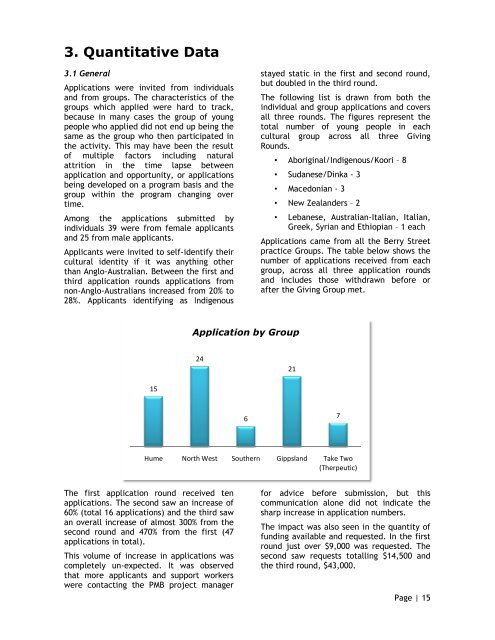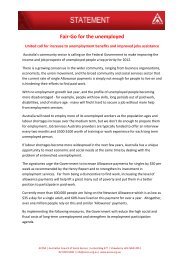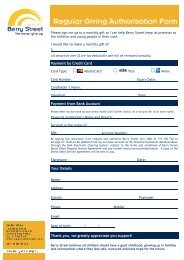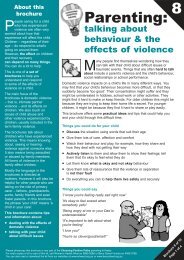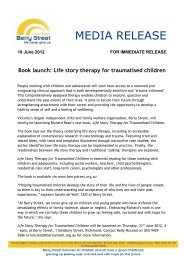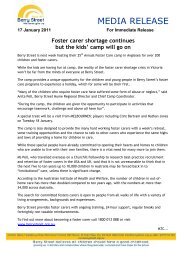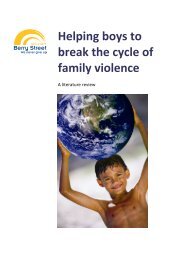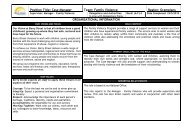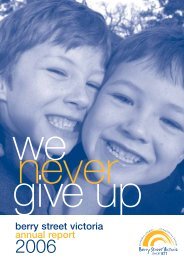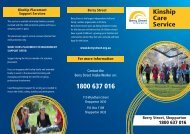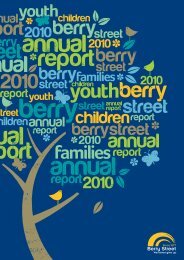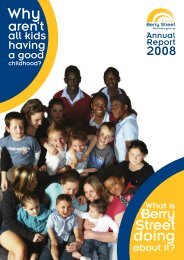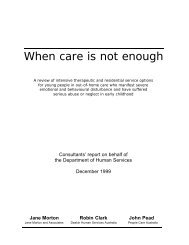Positive Memory Bank - Berry Street
Positive Memory Bank - Berry Street
Positive Memory Bank - Berry Street
You also want an ePaper? Increase the reach of your titles
YUMPU automatically turns print PDFs into web optimized ePapers that Google loves.
3. Quantitative Data<br />
3.1 General<br />
Applications were invited from individuals<br />
and from groups. The characteristics of the<br />
groups which applied were hard to track,<br />
because in many cases the group of young<br />
people who applied did not end up being the<br />
same as the group who then participated in<br />
the activity. This may have been the result<br />
of multiple factors including natural<br />
attrition in the time lapse between<br />
application and opportunity, or applications<br />
being developed on a program basis and the<br />
group within the program changing over<br />
time.<br />
Among the applications submitted<br />
by<br />
individuals 39 were from female applicants<br />
and 25 from male applicants.<br />
Applicants were invited to self-identify their<br />
cultural identity if it was anything other<br />
than Anglo-Australian. Australian. Between the first and<br />
third application rounds applications from<br />
non-Anglo-Australians Australians increased from 20% to<br />
28%. Applicants identifying as Indigenous<br />
stayed static in the first and second round,<br />
but doubled in the third round.<br />
The following list is drawn from both the<br />
individual and group applications and covers<br />
all three rounds. The figures represent the<br />
total number of young people in each<br />
cultural group<br />
across all three Giving<br />
Rounds.<br />
• Aboriginal/Indigenous/Koori – 8<br />
• Sudanese/Dinka - 3<br />
• Macedonian - 3<br />
• New Zealanders – 2<br />
• Lebanese, Australian-Italian, Italian,<br />
Greek, Syrian and Ethiopian – 1 each<br />
Applications came from all the <strong>Berry</strong> <strong>Street</strong><br />
practice Groups. The table below shows the<br />
number of applications received from each<br />
group, across all three application rounds<br />
and includes those withdrawn before or<br />
after the Giving Group met.<br />
Application by Group<br />
24<br />
21<br />
15<br />
6<br />
7<br />
Hume<br />
North West Southern Gippsland Take Two<br />
(Therpeutic)<br />
The first application round received ten<br />
applications. The second saw an increase of<br />
60% (total 16 applications) and the third saw<br />
an overall increase of almost 300% from the<br />
second round and 470% from the first (47<br />
applications in total).<br />
This volume of increase in applications was<br />
completely un-expected. . It was observed<br />
that more applicants and support workers<br />
were contacting the PMB project manager<br />
for advice before submission, but this<br />
communication alone did not indicate the<br />
sharp increase in application numbers.<br />
The impact was also seen in the quantity of<br />
funding available and requested. In the first<br />
round just over $9,000 was requested. The<br />
second saw requests totalling $14,500 and<br />
the third round, $43,000.<br />
Page | 15


